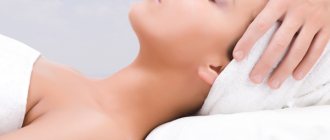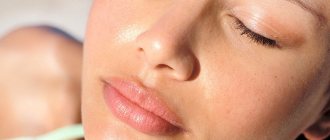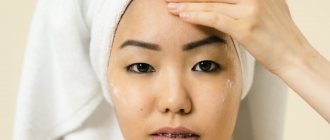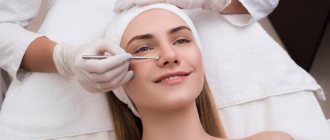Signs of thin skin
Sensitive and thin skin
With age, our skin type can change depending on lifestyle, climate, bad habits, dietary habits, professional conditions, cosmetics used, and past diseases.
Thin facial skin can be easily tested using a regular napkin. When you apply it to your face, you will never see traces of oil, since this type is prone to excessive dryness. This condition is caused by a decrease or complete absence of sebum production. It leads to loss of elasticity, firmness, premature aging and the appearance of a noticeable number of wrinkles. In addition, this type of skin is characterized by pronounced capillaries, which can give the face a red and unhealthy tint due to the thinness of the epidermis.
As for the skin around the eyes, in all women, without exception, it is dry and thin due to the lack of subcutaneous fatty tissue. If you start proper care from an early age, you will maintain and also significantly improve its condition for many years without the need to use radical and aggressive rejuvenation techniques.
Oily skin
Oily facial skin: what to do?
There are 4 skin types. Among them, oily facial skin causes the greatest number of problems, since it is characterized by a number of negative signs. Most often, patient dissatisfaction is caused by such characteristic signs as greasy shine, the presence of enlarged pores, and comedones. In addition, it is with this option that the development of various inflammatory elements is most typical. Cosmetologists know best what to do in cases where oily skin causes concern. It is in their competence to clarify the situation and competently care for oily facial skin.
Causes of oily skin
Increased activity of the sebaceous glands leads to the appearance of excessive oily skin. The predisposing factors for this are the following:
- Heredity and individual characteristics;
- Endocrine disorders;
- Non-compliance with the diet;
- Disturbances in the functioning of the gastrointestinal tract;
- Incorrectly selected skin care, low quality cleansing procedures.
Skin type is not a constant value, and in the course of life it can change. Oily skin is more common in young people under the age of 25. In the future, in most cases, it transforms into a combined type. However, in cases where the main causes of oily facial skin are genetic, its clinical signs may persist throughout life. This development of the situation is observed in 5-7% of the population.
Hormonal imbalance is the factor that most influences the increase in oily skin. This process can develop both during puberty and with endocrine pathology. In women, the causes of oily facial skin in adulthood can be polycystic ovary syndrome, insufficient thyroid function, pregnancy, menopause, and uncontrolled use of oral contraceptives. Stress also contributes significantly to the development of symptoms.
Unbalanced functioning of the gastrointestinal tract, especially its manifestations such as constipation, is another prerequisite that affects the increase in oily skin. Poor nutrition, consumption of preservatives, fatty or spicy foods, easily digestible carbohydrates, as well as alcohol and carbonated drinks are also a negative factor.
Characteristics of oily skin
The quality of the skin and excessive oiliness appear unevenly in different areas of the face, which is due to the peculiar distribution of the sebaceous glands in its thickness. It is the accumulation of excretory ducts in certain places that explains the causes of oily skin on the forehead, nose and chin area. Characteristic areas are also located in the back or décolleté area. Often such negative signs are combined with oily hair. In women and men, these signs are usually expressed equally.
Typical manifestations of oily skin are oiliness and a greasy shine. It seems thickened. Excess sebum accumulating on the surface contributes to clogging of pores, their expansion, the formation of blackheads, comedones, and whiteheads, milia. Externally, oily skin on the forehead, nose and chin area resembles an orange peel.
Such signs have a negative effect not only on aesthetics. Oily skin of the forehead and other areas of the T-zone becomes the most preferred location for the localization of inflammatory elements, acne. This is explained by the fact that the narrow duct of the sebaceous gland and the production of an excess amount of secretion contribute to blockage of the excretory ducts of the glands, stagnation of secretion in it and infection. As a result, pustules with purulent contents appear. What to do if oily skin on the forehead is accompanied by the formation of pustular elements, a dermatologist will clarify. It is within his competence to prescribe treatment for acne. The services of a cosmetologist will be in demand only after the inflammatory process has subsided.
However, oily skin also has a number of positive signs. It is more capable of retaining moisture than dry. In this regard, its turgor remains at the same level. Much later, people with oily skin develop wrinkles.
Features of oily skin care
If your facial skin is very oily, a cosmetologist will most competently explain what to do and how to improve its quality. It should be taken into account that incorrect measures, even the use of exclusively external means, can aggravate the situation. The lack of a competent approach in this case may be ineffective or dangerous. You need to trust the professionals. A qualified cosmetologist will select appropriate facial skin care products. If additional procedures are needed to achieve the desired effect, he will carry them out competently. The doctor’s actions in this case should be aimed at reducing the production of sebum and removing its excess, cleansing the pores.
At home, this effect can be achieved by the following steps:
- Thorough cleansing of the skin using foam, gel or mousse for oily skin. To get the desired effect, it is recommended to carry out the procedure twice a day;
- Excluding actions that promote the activity of the sebaceous gland and the formation of excess sebum. These include frequent scrubbing procedures, the use of hot water and a washcloth for washing, the use of fatty cream, and alcohol-containing tonic;
- Normalization of the diet, excluding foods that have a negative impact on the quality of the skin.
An important step towards correcting existing deficiencies is to find out the causes of excess oily skin. In this regard, in addition to the measures prescribed by the cosmetologist, it would not be amiss to consult an endocrinologist and gastroenterologist. It is in their competence to give recommendations on what to do if oily facial skin is caused by concomitant diseases. In some cases, without appropriate treatment, it will not be possible to achieve a lasting improvement in the situation. The required result will be achieved only with an integrated approach.
Of great importance in the fight against the negative signs that accompany oily skin is the correct choice of cosmetic products for daily care. They should all be designed for oily skin, absorb quickly, leaving no shine. Preference is given to a delicate consistency and liquid structure.
In such a situation, it is recommended to scrub the skin 1-2 times a week. It would be optimal to use a film mask as a cleansing procedure, which will most carefully remove dead cells from the surface layer of the dermis. Masks with anti-inflammatory, sebum-regulating, and keratolytic properties are also recommended.
Cosmetologists define what to do if your facial skin is too oily:
- In addition to regular home care, salon cleansing procedures are recommended;
- It is necessary to adhere to the diet;
- Comprehensive examination by related specialists regarding concomitant pathology.
Salon treatments for oily skin
Salon treatments are more effective than care provided at home. By normalizing the functioning of the sebaceous glands, they can improve the quality of the skin and reduce its oiliness in a shorter time. In this case, experts recommend the following measures:
- professional care for oily skin;
- cleansing procedures, cleansing, peeling;
- hardware techniques, ultraphonophoresis, darsonvalization;
- injection procedures, mesotherapy, biorevitalization;
- facial massage, which, by improving microcirculation in the facial area, helps normalize the functioning of the sebaceous glands;
- cryomassage procedure aimed at narrowing pores.
Facial skin cleansing activities are carried out by using external products, applying a cleansing mask, as well as peeling and cleansing. In this case, depending on predisposing factors, ultrasonic, mechanical, and chemical facial cleansing can be used.
Despite the emergence of more innovative means, it is with the help of manual manipulation and a special spoon that it is often possible to get rid of all blackheads during one session. Other procedures, although less traumatic, do not allow obtaining such a quick and pronounced result. However, during mechanical cleaning it is possible that areas of hyperemia may appear, so before important events in the client’s life, specialists give preference to ultrasonic cleaning.
Among procedures aimed at eliminating excess oily skin, all-season peels are very popular. A special role is given to enzymatic peeling, the activity of which is ensured by enzymes. They destroy the substance that holds the horny scales, thereby promoting their independent exfoliation. The gentle effect and the absence of mechanical forces during the procedure ensure its safety and allow peeling not only in the salon, but also at home.
Here are a few questions that our clinic clients most often ask us.
Is it necessary to use moisturizer if you have oily skin?
Although oily skin loses moisture less rapidly than dry skin, it should also be hydrated.
A sufficient amount of hyaluronic acid, thermal water and other hydrofixatives in the composition of external products ensures the process of renewal of the epidermis. Thus, the necessary cleansing effect is achieved and the appearance of oily skin is reduced. How to deal with oily shine throughout the day?
In order to mask the greasy shine as efficiently as possible, you need to choose the right choice of both medicinal and decorative cosmetics.
Care products should be designed for oily skin and have a delicate texture. If possible, cleansing the skin should be done at least 2 times a day. Foundations and shadows should be powdery in nature with a mattifying effect. Creamy cosmetics will only emphasize the signs of oiliness. How to wipe your face if you have oily skin?
Cold water helps to tone oily skin and narrow pores, so some improvement can be achieved by rubbing the skin with ice cubes. The cosmetics industry is also replete with tonics designed for oily skin. The absence of alcohol in them eliminates the increase in the activity of the sebaceous gland. At the same time, they contain extracts of plant herbs that have a mattifying effect.
Features of care for thin skin of the face and around the eyes
Thin skin requires regular care
Thin skin types do not tolerate washing with soap well, becoming thinner and dehydrated even more each time. However, if you cannot do without this usual procedure, use soft water that has gone through the boiling process. Soap can be used once a week, not more often. As a cleaning agent, you can use egg yolk, rich in valuable vitamins and microelements, white bread crumb infused with milk, steamed oatmeal, and sour cream.
Before washing, it is best to lubricate the area around the eyes with a thin layer of olive or any other plant-based oil.
Do not rub or stretch such skin under any circumstances. Perform all movements easily and carefully, avoiding the appearance of irritation and folds. Cosmetologists advise cleaning it in the morning with special products in the form of milk, lotion, thermal water, which are not able to remove the lipid protective layer created overnight. They must be completely free of alcohols and components that dry out the epidermis (acids, abrasives), otherwise the effect will be the opposite.
Try to spend less time in the sun, since ultraviolet radiation is the main cause of dryness, early aging and thinning of the skin layer.
If exposure to the sun cannot be avoided, be sure to use protective products containing special filters that reflect directed rays and prevent the aggressive, destructive effects of the sun on epidermal cells.
In winter, before going outside, be sure to lubricate your skin with nourishing creams containing a high percentage of fats and natural oils that tighten and tone the turgor.
Every evening massage of the face and area around the eyes can significantly improve blood supply and, as a result, nutrition of thin skin. It should be performed with your fingertips after cleansing your face and before applying caring cosmetics. Movements should be neat, light, directed from the middle of the face to the temples, that is, strictly along the massage lines.
Care - basic rules
There are recommendations both for specific types and general ones. For any skin, it is important to carry out daily care in three stages:
Cleanse. Washing with any product. Twice, morning and evening. Prepares the epidermis for the second stage. It is better to carry out with water at room temperature.
Tone. Residues of cleanser are removed and pores are narrowed. A tonic is used.
Moisturize. The cream is necessary to maintain the skin's natural moisture level. It is best to choose a cream with ultraviolet protection (SPF from 30).
What active ingredients should be present in eye cosmetics?
Cosmetics for eyes with thin skin should be special
High-quality compositions included in cosmetic products for the care of thin and dry skin necessarily contain the following components, the action of which is to restore, moisturize, nourish and strengthen both the outer and inner layers of the skin:
- retinol or vitamin A, involved in cell regeneration (renewal), improvement of microcirculation, hydration, nutrition, firmness support, elasticity, general rejuvenation;
- lanolin, containing a large percentage of animal fats, instantly nourishes, protects and thickens the turgor;
- vegetable oils with a high content of vitamin E of youth and beauty (jojoba, olive, burdock, peach, almond, wheat germ);
- allantoin or bisabolol (restore damaged cells, prevent dryness and irritation of the epidermis, protect against the aggressive action of most external factors);
- hyaluronic acid (has active moisturizing, rejuvenating, promoting healing, and the production of its own collagen substances);
- vitamin C (strengthens the walls of blood vessels and small capillaries, prevents their fragility, redness and thickening - rosacea);
- extracts or decoctions of natural herbs and plants (eliminate inflammatory effects, saturate the skin with antioxidants, rejuvenate and renew).
Treatment
In a medical setting, a set of procedures aimed at caring for the skin of the face and body is selected individually.
Effective medical rejuvenation procedures are as follows:
- Mesotherapy is the subcutaneous administration of vitamin cocktails and other drugs beneficial to the skin.
- Biorevitalization – saturation of the deep layers of the skin with hyaluronic acid.
- Also, high-quality care is provided by peeling procedures, massage, etc.
Our cosmetologists will tell you how to choose the right skincare products and show you facial exercises that can slow down skin aging.
The most effective natural homemade masks for skin tightening, renewal and nutrition
Masks will bring the long-awaited effect only with regular use
Very often, thin and dry skin reacts negatively to factory-made cosmetics with the appearance of irritation, redness and swelling. For those with sensitive skin, we recommend preparing the following simple masks from available ingredients 3 times a week, preferably in the evening.
Do not forget that masks will bring the long-awaited effect only with regular use, as well as if they are applied to clean skin, free of cosmetics and impurities.
- Based on cucumber juice. You will need to mix 50 ml of juice from fresh, finely grated cucumber with egg yolk, 10 ml of almond oil, 1 ampoule of retinol - vitamin A and 1 ampoule of vitamin E (sold at the pharmacy). Add wheat flour to the consistency of sour cream, mixing everything thoroughly.
- Based on parsley juice. You will need 20 ml of olive oil, 10 grams of potato flour and parsley chopped in a blender. Mix all ingredients well and apply.
- Avocado based. Avocado pulp, converted into a mushy mass in the amount of 20 grams, is mixed with 10 ml of cold-pressed olive oil, everything is mixed well.
- Spinach based mask. Take 20 ml of fresh spinach juice, add 1 ampoule of vitamin A and 10 grams of baby fat cream to it, mix everything thoroughly and apply.
- Starch based. Potato starch in an amount of 30 grams is mixed with 15 ml of high-fat cream, and the mixture is left for 30 minutes. Then add 30 ml of vitamin E oil pharmaceutical concentrate (in ampoules) to the composition and leave the mass in the refrigerator for 3 hours. Before use, add 10 grams of finely chopped mint and parsley and mix thoroughly.
Don't forget that a varied diet, good sleep, a healthy lifestyle, and giving up bad habits can have a positive effect on the condition of your skin!
By receiving constant care with cleansing, moisturizing, nourishing and protecting, your skin will be filled with radiance, health and elasticity so that you always remain young, beautiful and desirable!
TOP 12 reasons for loss of skin elasticity at any age
- Incorrect posture.
Do you slouch and pull your head forward when sitting at the computer? Do you read while lying down? Do you sleep curled up on one side? All this steals youth from your face. - Physical and emotional fatigue.
Due to stress and heavy workload, the face can become haggard. Pale color with an earthy tint, sunken eyes, folded skin - a familiar portrait? - Eating disorder.
Harmful, unbalanced, poor or excessive nutrition - all this harms the skin. The body must receive a sufficient amount of nutrients, vitamins, minerals and not an ounce of “food waste”. - Weight fluctuations.
Due to the accumulation of kilograms, the skin stretches, and as a result of sudden weight loss, it sags. - Cigarettes and alcohol.
They dry out the skin and deprive it of its protective properties. Have you seen photos of twins, one of whom smokes, the other does not? Look for them on the Internet, they are more eloquent than any words. The smoker's facial skin will be flabby, saggy, wrinkled, gray-sallow, while her twin's will be elastic and fresh. - Physical inactivity.
A sedentary lifestyle slows down blood circulation, metabolism, nutrition and cell regeneration. - Hormonal imbalances.
Women's skin reacts especially sensitively to the level of its “beauty hormone” - estrogen. If there is not enough of it, the skin fades. Typically, estrogen production decreases during menopause, but hormonal imbalances also occur at a young age. - Lack of fluid.
The clean water you drink quickly reaches your skin and gives it the moisture it needs. If you drink little, your skin becomes dry and flabby. - Aggressive external factors: sun, frost, wind, dust, dry air.
Excessive exposure to ultraviolet rays is especially harmful. They destroy elastin and collagen fibers - the “building” protein on which the youth of the skin depends. - Most cosmetic procedures.
Any external invasion - plastic surgery, threads, Botox injections, fillers - weanes the skin (as well as other tissues and organs) from working correctly. The external effect of the procedure only lasts for a while, but negative processes occur inside that lead to aging. - Incorrect use of cosmetics.
You need to monitor the composition of cosmetic products, do not overuse decorative cosmetics, and follow the rules of the daily “cleansing-moisturizing-nutrition” ritual. - Pathological reasons.
This includes disorders of the nervous, endocrine, cardiovascular systems, gastrointestinal tract, etc.
The role of proper nutrition in skin care
Proper nutrition is the basis for the whole body as a whole. After all, vitamins and minerals, healthy acids and fats enter the blood through the intestines.
At the age of 40, you need to change your usual diet and pay attention to the following foods:
- Vegetable oils such as flaxseed, hemp, olive - they are rich in vitamins and do not accumulate excess fat.
- It is beneficial to eat fatty fish - it is a source of large amounts of vitamin D and group B, Omega-3 fatty acids and selenium.
- From the age of 35, the female body produces less of the phytoestrogen hormone, which is responsible for beauty and youth. Flax seeds or oil, legumes, and tomatoes will help compensate for its deficiency.
- Be sure to increase the amount of vegetables and fruits.
- An important product for women's youth is soy.
- It is beneficial for women to consume fermented milk products, 1% fat cottage cheese, and yogurt.
- It is better to reduce your coffee intake, as well as very strong tea.
- You should completely avoid fast foods and sweet carbonated water.
You shouldn’t start sudden active diets after 40 years, this will affect the condition of the skin. The skin begins to sag and if you do not introduce physical exercise into your daily routine, there will be no positive effect.
It is important not to abuse alcohol and tobacco products, get good sleep and maintain hormonal balance. Therefore, proper nutrition when caring for your skin will help not only maintain beauty, but also overall health.
What foods help improve skin elasticity?
For youthful and elastic skin, it is useful to consume products containing:
- silicon (bran, oats, barley, black bread, potatoes, peppers, celery, onions, radishes, tomatoes, parsley),
- iron (buckwheat, egg yolk, oatmeal, liver, rabbit, chicken, veal, lamb),
- selenium (whole grain wheat bread, brown rice, coconuts, Brazil nuts, sardines, tuna, liver, garlic, eggs),
- zinc (seafood, fish, beef liver and meat, mushrooms, nuts, wheat bran).
Make sure you have plenty of vitamins in your diet. There is no point in talking about the benefits of each of them separately, because to rejuvenate the skin and increase its elasticity, they all are needed: A, B, C, D, E, F, K, N, P, PP.
First of all, vitamins A (retinol), B5 (panthenol), B7 (biotin), B9 (folic acid), C (ascorbic acid), E (tocopherol), F (linoleic acid) are useful for youthful skin.
When there is a need to improve skin elasticity
When should you start taking care of keeping your skin elastic? If you read the top 12 reasons for loss of elasticity, then you can answer this question yourself. This should always be done.
The girl was recently born, and we are already protecting the baby from the sun, monitoring her nutrition, fluid intake, sleep, posture, and health. We, of course, do not think about any elasticity of the skin, but we are already laying the foundation.
In adolescence, a girl begins to take care of her skin herself - she moves to a conscious stage, but for now it is about maintaining the beauty that nature has given her.
And the new milestone is 25-30 years. At this age, aging mechanisms begin. You need to carefully monitor the condition of your skin on all counts, strengthen your care with anti-aging products, include exercises and self-massage of the face. The sooner you start doing all this, the longer you will maintain your youth.
And it's never too late to start taking care of your face. Natural rejuvenation techniques can make your skin firmer at any age.











